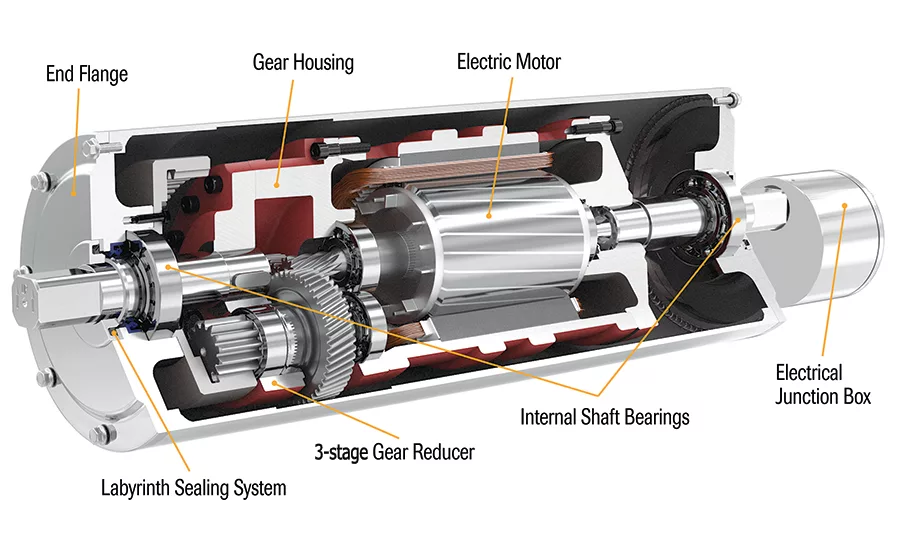Engineering R&D
Thinking inside--and outside--the box
Drum motors are well suited to food and beverage conveying applications where motors should be out of sight, safe and clean.


The drum motor is a one-component conveyor drive; no external rotating components or pinch points are outside of the conveyor frame. Source: Van der Graaf.
Driving a conveyor head roller with a drum motor, which features a motor and gear box within the roller housing, is not a new concept. For around 70 years, this design has addressed space utilization issues by incorporating all external components inside the drum. However, the design has lacked the electrical and mechanical efficiency that can contribute substantially to energy savings and has been known to present some seal integrity issues.
Today, the practical drum motor designs used in food processing plants protect all vital motor/gearing components within an IP69K stainless steel enclosure. These motors can withstand up to 3,000 psi of washdown pressure, without scheduled maintenance. Outside-the-box-thinking led to this improved design, with the motor, gear reducer and bearings inside the box, making it safer and more energy efficient. Plus, since no rotating components or pinch points are outside the conveyor frame, the drum motor conveyor drive protects personnel working around the equipment.
FE caught up with Alexander Kanaris, president of Van der Graaf, at FE’s recent Food Automation & Manufacturing Conference to find out about the latest developments in drum motor technology. Established in 1948 in the Netherlands, Van der Graaf began manufacturing drum motors in Toronto, Canada in 1985. Shortly afterward, it began operations in Shelby, MI. Over the years, the company’s North American manufacturing space has grown from 3,500 sq. ft. to over 200,000 sq. ft. Kanaris holds more than 25 patents.
FE: Tell us a little about yourself.
Alexander Kanaris: I have been involved in electromechanical designs and manufacturing since 1978. As an electrical engineer, I have specialized in electrical motor designs including three-phase, single-phase and DC motors, from fractional to 3,000 hp. In 1985, with the help and support of Mr. M. H. Van der Graaf of the Netherlands, I founded Van der Graaf in Toronto and, immediately after that, started designing and manufacturing drum motors. Many changes have occurred over the last 31 years. Not only has the design of the drum motor changed, the manufacturing process has involved using new technology, state-of-the-art CNC machinery including robotics, and automation.
FE: When did drum motors become applicable to the food industry?
Kanaris: The food industry was first targeted in 1985. By design, the drum motor addresses efficiency, maintenance and cost of ownership, but more important for the food industry, it also addresses sanitation. In standard conveyor designs, the washdown process tends to be more complicated and difficult to perform since the motor and gear box are exposed and have more crevices that can harbor bacteria. But, all the drive components of the drum motor are contained within a stainless steel cylinder, totally shielded from the external environment. So, it can withstand washdown pressures up to 3,000 psi.
FE: What design changes were necessary to make the drum motor suitable for food and beverage applications?
Kanaris: In the last decade, food processing companies have adopted many changes to address sanitation and worker safety, improve equipment efficiencies, lower operational costs and streamline conveyor designs for better space utilization. Belt manufacturers are addressing sanitation concerns by introducing new modular belt designs, as well as extruded belts, to minimize crevices that can harbor bacteria and to make the washdown cleaning process easier.
In the past, the IP57 enclosure was the accepted standard in the industry. Then, it became IP67. Now, the enclosure standard is IP69K. To keep up with ever-changing demands, Van der Graaf has made changes to the drum motor. For instance, we made substantial design changes to the drum, end flanges, shafts and electrical connection box to address new enclosure standards and minimize the possibility of water ingress. The chemical composition of the detergents and the washdown pressure used to sanitize conveyors also have changed. Consequently, Van der Graaf has designed a new labyrinth sealing system that can accept detergents with a pH range from two to 11.
And, to accommodate new modular and extruded positive-driven belts, Van der Graaf has undergone drum profile design changes, such as drive sprocket designs to drive modular belts from different belt manufacturers.
FE: What future designs are you planning?
Kanaris: Van der Graaf’s future designs focus on more efficient gear reducers that are higher in ratio and can handle higher torque and lower linear speeds with lower gear noise. The new design of the electric motor features a higher electric motor efficiency and lower energy usage. Van der Graaf is currently working on much higher capacity drum motors up to 36 inches in diameter and up to 300 hp to service non-food related industries.
FE: What types of conveyor belting can the drum motor accommodate?
Kanaris: With the use of sprockets or continuous profile drum designs, the Van der Graaf drum motor can accommodate modular, extruded or thermoplastic belts from many belt manufacturers such as Intralox, Habasit, Rexnord and Volta.
FE: Can the motor be used in indexing applications?
Kanaris: Yes. Proximity sensors are available for a closed loop system to control the belt speed and to allow the motor to be used for indexing applications. It is a standard electric, three-phase motor that can be easily reversed by interchanging any of two motor leads.
FE: What design work has been done to prevent washing fluids from entering the motor or cable exit?
Kanaris: Water ingress in food plants undergoing frequent high-pressure washdowns has been particularly harsh on electric motors. Water and electricity are not a good mix. With the drum motor design, the electric motor is protected in an oil bath inside the stainless steel cylinder, and the labyrinth sealing system on the end flanges of the drum motor prevents water ingress into the drum. On the cable entry side, watertight cable connectors prevent water ingress.
FE: What’s the latest in metallurgic design to prevent pitting and corrosion of the stainless steel motor surface?
Kanaris: The pitting and corrosion problem is often seen on motor parts manufactured from aluminum or low-grade stainless steel with a high carbon content. The Van der Graaf sanitary drum motor is manufactured using 316L low-carbon stainless steel to avoid pitting and corrosion.
FE: Is your drum motor usually cleaned in place?
Kanaris: The drum motor is a one-component conveyor drive. There are no separate components working outside the conveyor frame. One of the benefits of using a drum motor in food plant conveyors is having the ability to clean it in place, without having to remove the unit from the conveyor frame.
FE: Within the food industry, is this motor type suitable for applications other than conveying?
Kanaris: Usage for the drum motor in the food industry extends beyond washdown and conveying applications. Any belt conveyor can be run with a drum motor.
FE: How safe and energy efficient is the drum motor?
Kanaris: There are no external components that could result in bodily harm, and the sanitation integrity of the drum motor is much higher than that of the conventional drive. The drum motor saves an average of 25 percent in energy costs compared to most commonly used conventional conveyor drives.
Alexander Kanaris can be reached at 905-793-8100 (ext. 222), akanaris@vandergraaf.com.
Looking for a reprint of this article?
From high-res PDFs to custom plaques, order your copy today!





